Leadership and Operational Management in Tesco
VerifiedAdded on 2020/10/22
|16
|4400
|153
AI Summary
This report delves into the leadership and operational management aspects of Tesco, a multinational retail corporation. It examines the roles and responsibilities of leaders and managers within the organization, as well as their approaches to managing operations and making decisions. The document also touches upon the importance of company values and culture in determining business success.
Contribute Materials
Your contribution can guide someone’s learning journey. Share your
documents today.
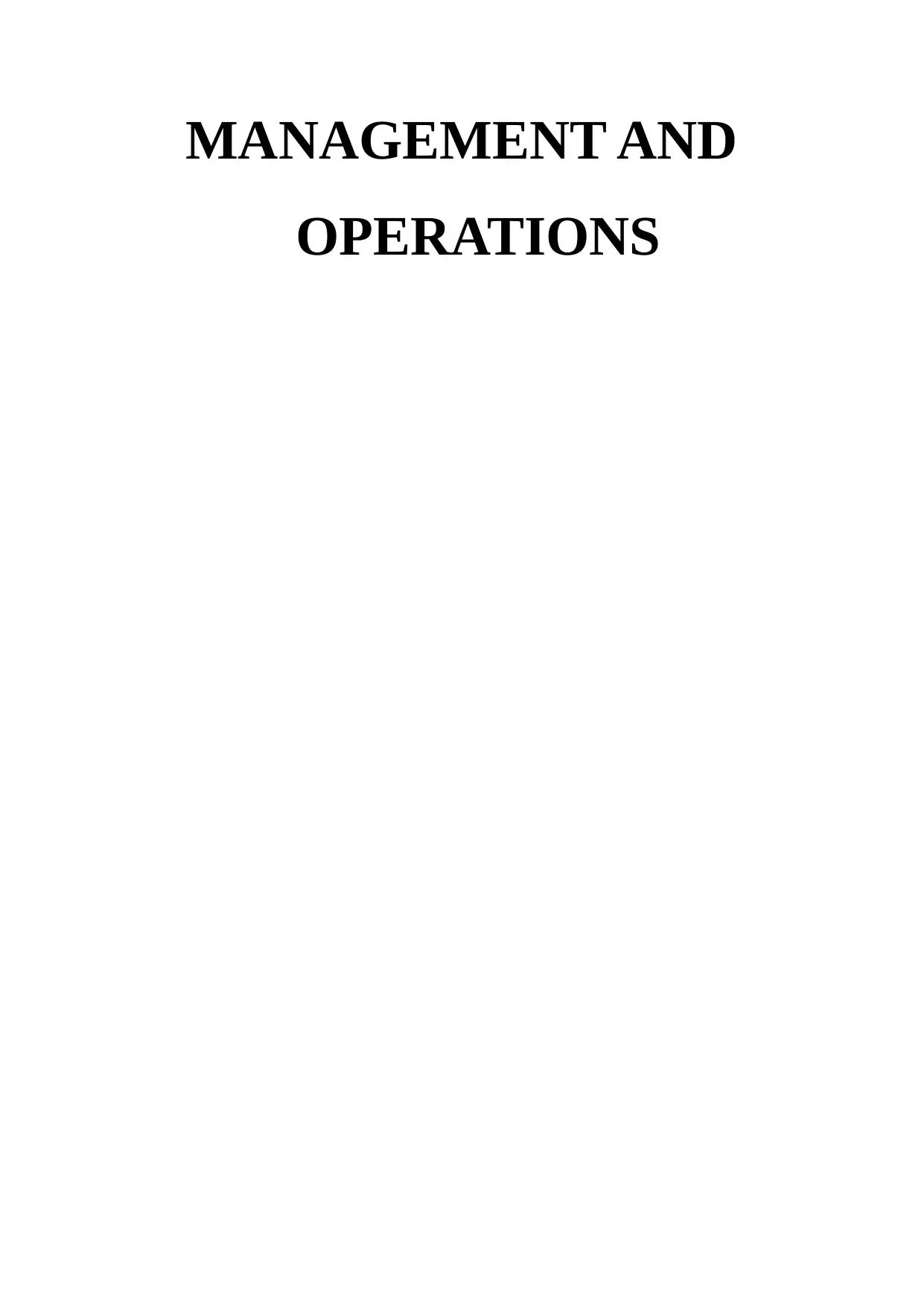
MANAGEMENT AND
OPERATIONS
OPERATIONS
Secure Best Marks with AI Grader
Need help grading? Try our AI Grader for instant feedback on your assignments.
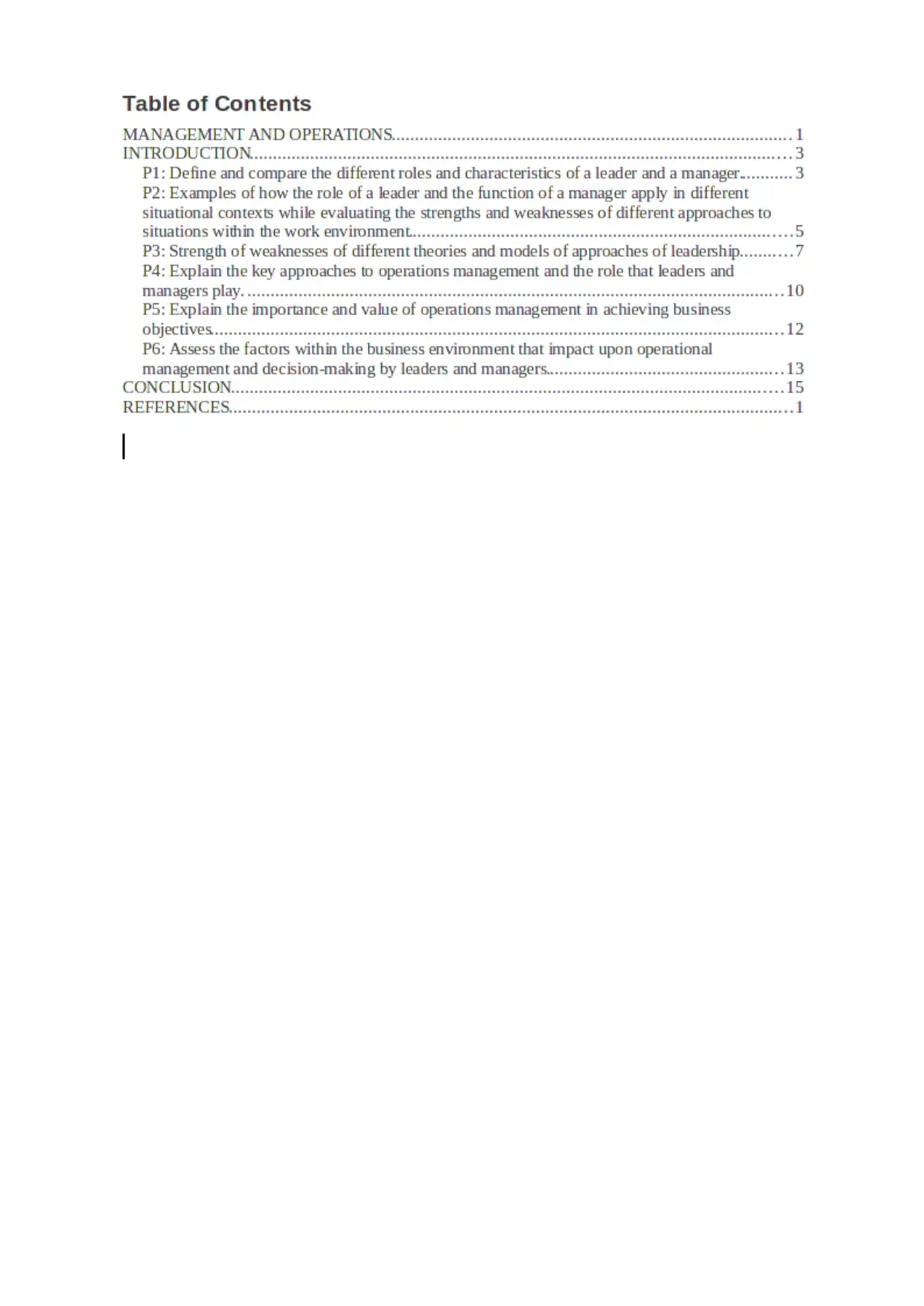
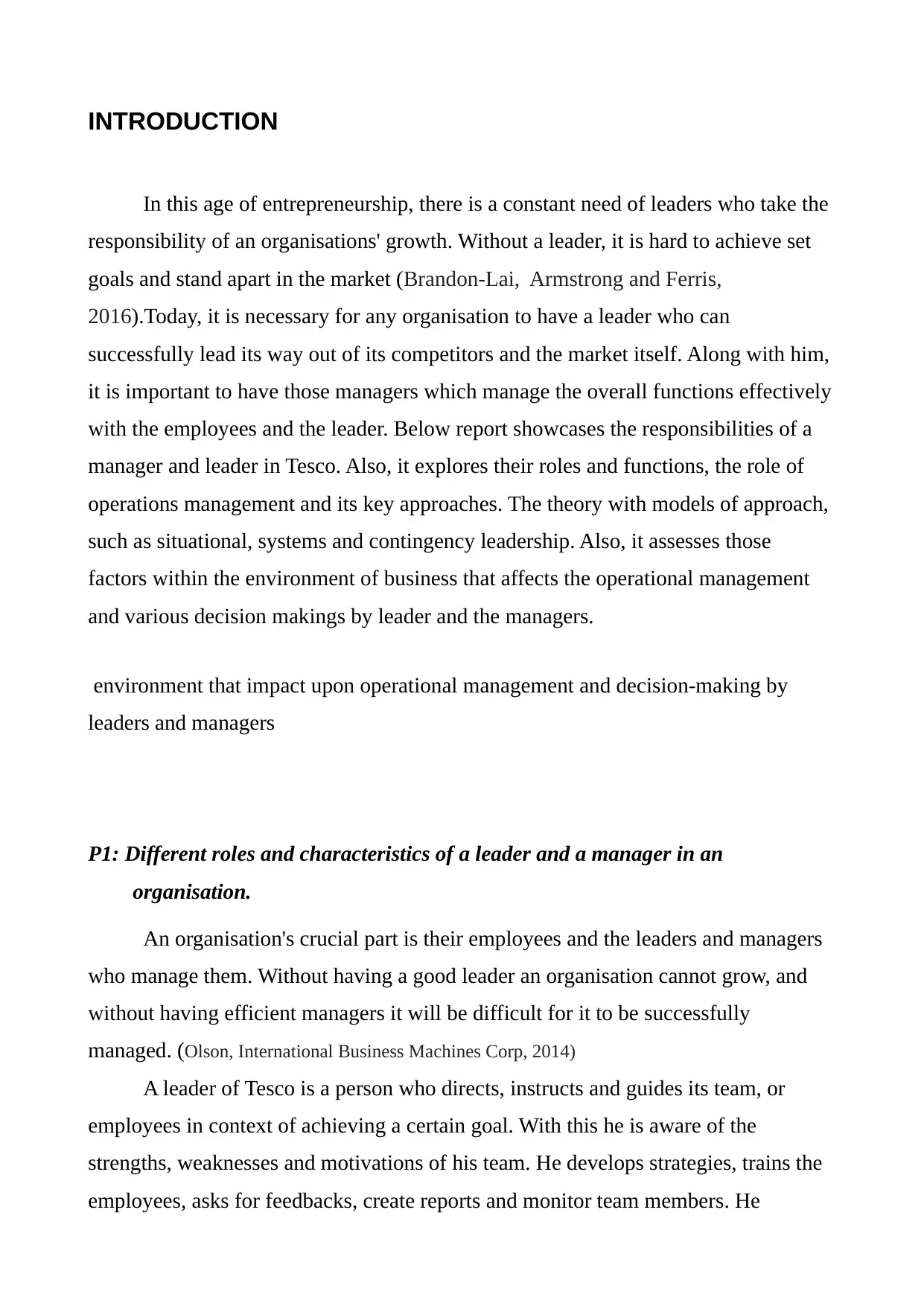
INTRODUCTION
In this age of entrepreneurship, there is a constant need of leaders who take the
responsibility of an organisations' growth. Without a leader, it is hard to achieve set
goals and stand apart in the market (Brandon-Lai, Armstrong and Ferris,
2016).Today, it is necessary for any organisation to have a leader who can
successfully lead its way out of its competitors and the market itself. Along with him,
it is important to have those managers which manage the overall functions effectively
with the employees and the leader. Below report showcases the responsibilities of a
manager and leader in Tesco. Also, it explores their roles and functions, the role of
operations management and its key approaches. The theory with models of approach,
such as situational, systems and contingency leadership. Also, it assesses those
factors within the environment of business that affects the operational management
and various decision makings by leader and the managers.
environment that impact upon operational management and decision-making by
leaders and managers
P1: Different roles and characteristics of a leader and a manager in an
organisation.
An organisation's crucial part is their employees and the leaders and managers
who manage them. Without having a good leader an organisation cannot grow, and
without having efficient managers it will be difficult for it to be successfully
managed. (Olson, International Business Machines Corp, 2014)
A leader of Tesco is a person who directs, instructs and guides its team, or
employees in context of achieving a certain goal. With this he is aware of the
strengths, weaknesses and motivations of his team. He develops strategies, trains the
employees, asks for feedbacks, create reports and monitor team members. He
In this age of entrepreneurship, there is a constant need of leaders who take the
responsibility of an organisations' growth. Without a leader, it is hard to achieve set
goals and stand apart in the market (Brandon-Lai, Armstrong and Ferris,
2016).Today, it is necessary for any organisation to have a leader who can
successfully lead its way out of its competitors and the market itself. Along with him,
it is important to have those managers which manage the overall functions effectively
with the employees and the leader. Below report showcases the responsibilities of a
manager and leader in Tesco. Also, it explores their roles and functions, the role of
operations management and its key approaches. The theory with models of approach,
such as situational, systems and contingency leadership. Also, it assesses those
factors within the environment of business that affects the operational management
and various decision makings by leader and the managers.
environment that impact upon operational management and decision-making by
leaders and managers
P1: Different roles and characteristics of a leader and a manager in an
organisation.
An organisation's crucial part is their employees and the leaders and managers
who manage them. Without having a good leader an organisation cannot grow, and
without having efficient managers it will be difficult for it to be successfully
managed. (Olson, International Business Machines Corp, 2014)
A leader of Tesco is a person who directs, instructs and guides its team, or
employees in context of achieving a certain goal. With this he is aware of the
strengths, weaknesses and motivations of his team. He develops strategies, trains the
employees, asks for feedbacks, create reports and monitor team members. He
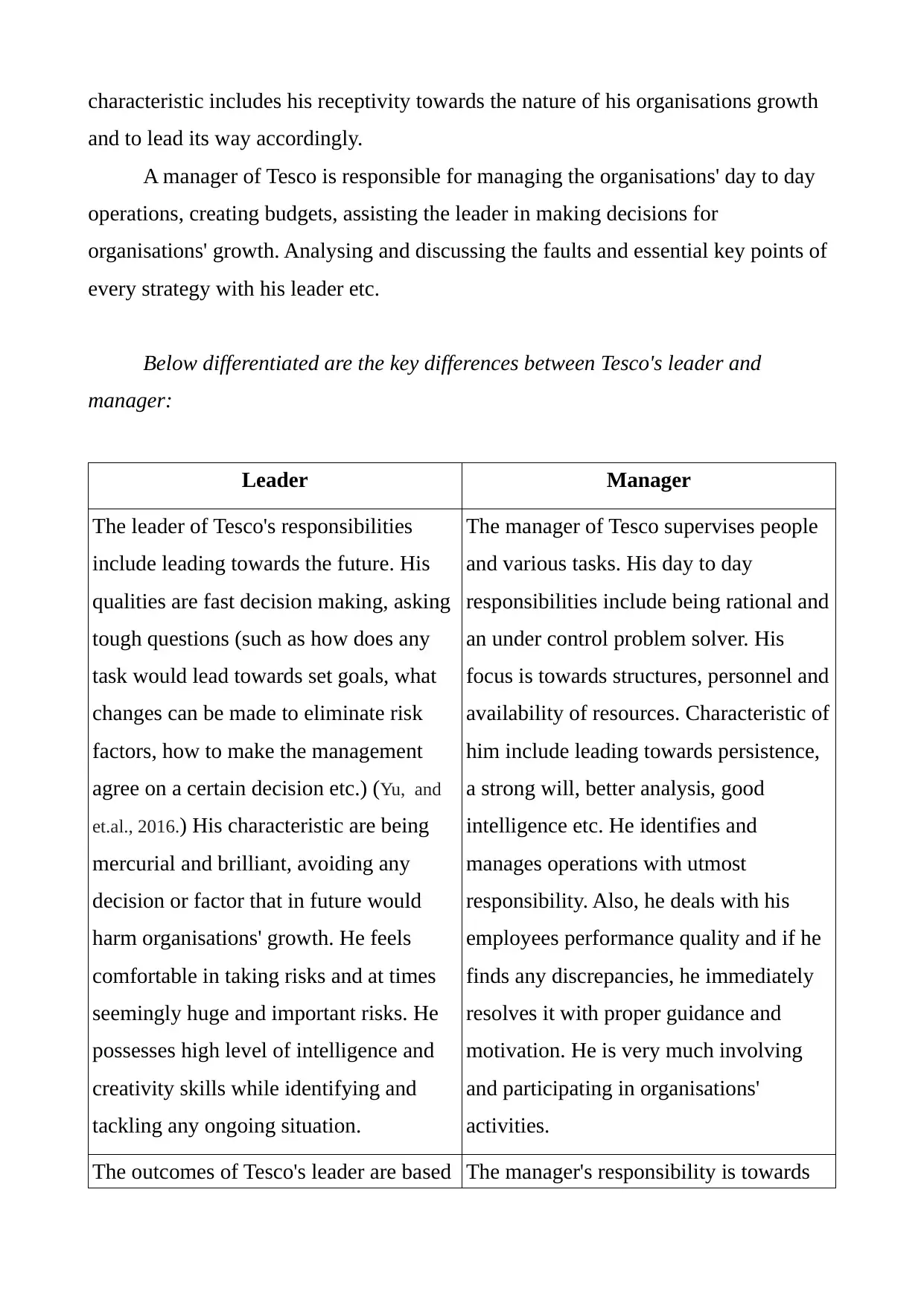
characteristic includes his receptivity towards the nature of his organisations growth
and to lead its way accordingly.
A manager of Tesco is responsible for managing the organisations' day to day
operations, creating budgets, assisting the leader in making decisions for
organisations' growth. Analysing and discussing the faults and essential key points of
every strategy with his leader etc.
Below differentiated are the key differences between Tesco's leader and
manager:
Leader Manager
The leader of Tesco's responsibilities
include leading towards the future. His
qualities are fast decision making, asking
tough questions (such as how does any
task would lead towards set goals, what
changes can be made to eliminate risk
factors, how to make the management
agree on a certain decision etc.) (Yu, and
et.al., 2016.) His characteristic are being
mercurial and brilliant, avoiding any
decision or factor that in future would
harm organisations' growth. He feels
comfortable in taking risks and at times
seemingly huge and important risks. He
possesses high level of intelligence and
creativity skills while identifying and
tackling any ongoing situation.
The manager of Tesco supervises people
and various tasks. His day to day
responsibilities include being rational and
an under control problem solver. His
focus is towards structures, personnel and
availability of resources. Characteristic of
him include leading towards persistence,
a strong will, better analysis, good
intelligence etc. He identifies and
manages operations with utmost
responsibility. Also, he deals with his
employees performance quality and if he
finds any discrepancies, he immediately
resolves it with proper guidance and
motivation. He is very much involving
and participating in organisations'
activities.
The outcomes of Tesco's leader are based The manager's responsibility is towards
and to lead its way accordingly.
A manager of Tesco is responsible for managing the organisations' day to day
operations, creating budgets, assisting the leader in making decisions for
organisations' growth. Analysing and discussing the faults and essential key points of
every strategy with his leader etc.
Below differentiated are the key differences between Tesco's leader and
manager:
Leader Manager
The leader of Tesco's responsibilities
include leading towards the future. His
qualities are fast decision making, asking
tough questions (such as how does any
task would lead towards set goals, what
changes can be made to eliminate risk
factors, how to make the management
agree on a certain decision etc.) (Yu, and
et.al., 2016.) His characteristic are being
mercurial and brilliant, avoiding any
decision or factor that in future would
harm organisations' growth. He feels
comfortable in taking risks and at times
seemingly huge and important risks. He
possesses high level of intelligence and
creativity skills while identifying and
tackling any ongoing situation.
The manager of Tesco supervises people
and various tasks. His day to day
responsibilities include being rational and
an under control problem solver. His
focus is towards structures, personnel and
availability of resources. Characteristic of
him include leading towards persistence,
a strong will, better analysis, good
intelligence etc. He identifies and
manages operations with utmost
responsibility. Also, he deals with his
employees performance quality and if he
finds any discrepancies, he immediately
resolves it with proper guidance and
motivation. He is very much involving
and participating in organisations'
activities.
The outcomes of Tesco's leader are based The manager's responsibility is towards
Secure Best Marks with AI Grader
Need help grading? Try our AI Grader for instant feedback on your assignments.
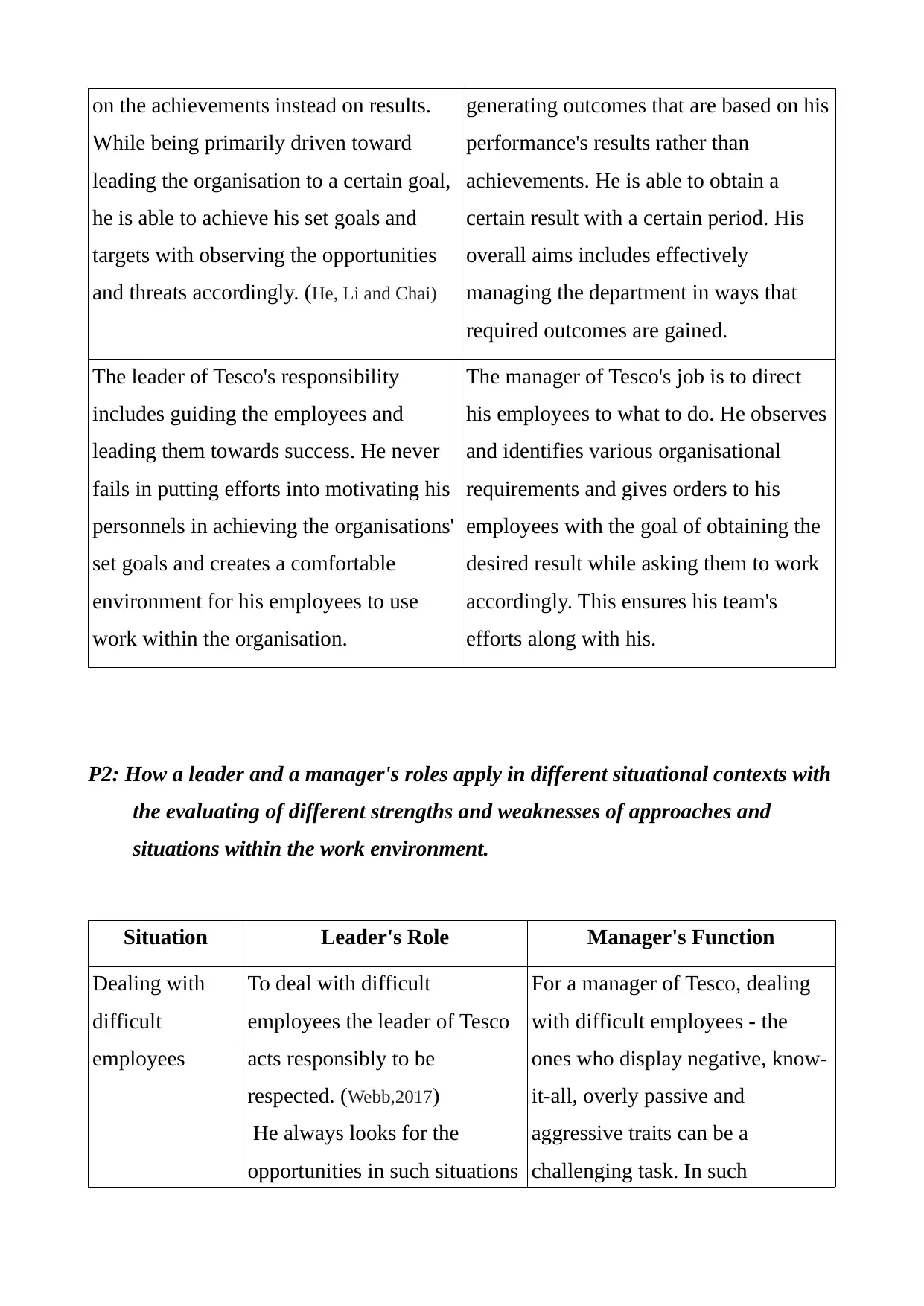
on the achievements instead on results.
While being primarily driven toward
leading the organisation to a certain goal,
he is able to achieve his set goals and
targets with observing the opportunities
and threats accordingly. (He, Li and Chai)
generating outcomes that are based on his
performance's results rather than
achievements. He is able to obtain a
certain result with a certain period. His
overall aims includes effectively
managing the department in ways that
required outcomes are gained.
The leader of Tesco's responsibility
includes guiding the employees and
leading them towards success. He never
fails in putting efforts into motivating his
personnels in achieving the organisations'
set goals and creates a comfortable
environment for his employees to use
work within the organisation.
The manager of Tesco's job is to direct
his employees to what to do. He observes
and identifies various organisational
requirements and gives orders to his
employees with the goal of obtaining the
desired result while asking them to work
accordingly. This ensures his team's
efforts along with his.
P2: How a leader and a manager's roles apply in different situational contexts with
the evaluating of different strengths and weaknesses of approaches and
situations within the work environment.
Situation Leader's Role Manager's Function
Dealing with
difficult
employees
To deal with difficult
employees the leader of Tesco
acts responsibly to be
respected. (Webb,2017)
He always looks for the
opportunities in such situations
For a manager of Tesco, dealing
with difficult employees - the
ones who display negative, know-
it-all, overly passive and
aggressive traits can be a
challenging task. In such
While being primarily driven toward
leading the organisation to a certain goal,
he is able to achieve his set goals and
targets with observing the opportunities
and threats accordingly. (He, Li and Chai)
generating outcomes that are based on his
performance's results rather than
achievements. He is able to obtain a
certain result with a certain period. His
overall aims includes effectively
managing the department in ways that
required outcomes are gained.
The leader of Tesco's responsibility
includes guiding the employees and
leading them towards success. He never
fails in putting efforts into motivating his
personnels in achieving the organisations'
set goals and creates a comfortable
environment for his employees to use
work within the organisation.
The manager of Tesco's job is to direct
his employees to what to do. He observes
and identifies various organisational
requirements and gives orders to his
employees with the goal of obtaining the
desired result while asking them to work
accordingly. This ensures his team's
efforts along with his.
P2: How a leader and a manager's roles apply in different situational contexts with
the evaluating of different strengths and weaknesses of approaches and
situations within the work environment.
Situation Leader's Role Manager's Function
Dealing with
difficult
employees
To deal with difficult
employees the leader of Tesco
acts responsibly to be
respected. (Webb,2017)
He always looks for the
opportunities in such situations
For a manager of Tesco, dealing
with difficult employees - the
ones who display negative, know-
it-all, overly passive and
aggressive traits can be a
challenging task. In such
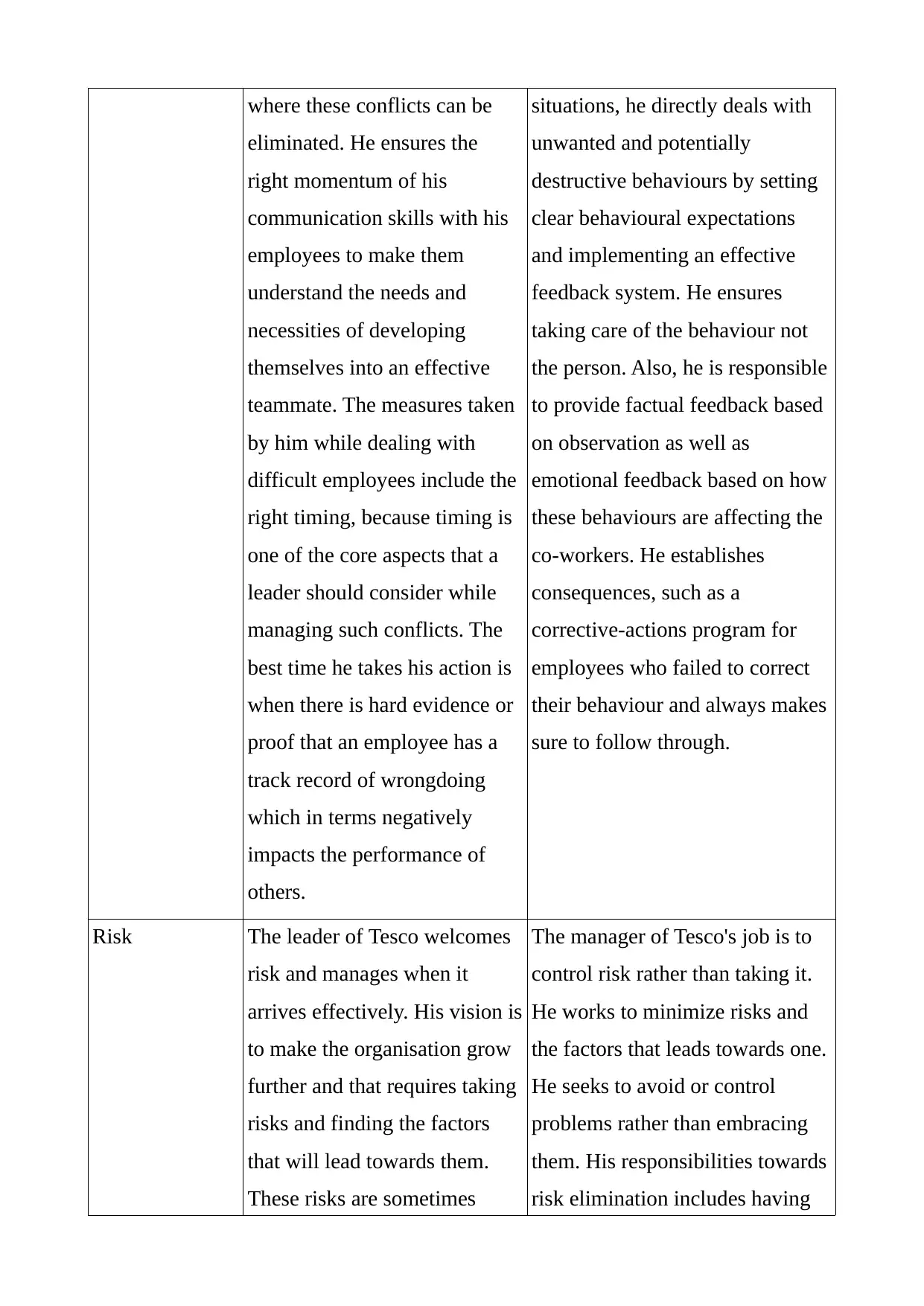
where these conflicts can be
eliminated. He ensures the
right momentum of his
communication skills with his
employees to make them
understand the needs and
necessities of developing
themselves into an effective
teammate. The measures taken
by him while dealing with
difficult employees include the
right timing, because timing is
one of the core aspects that a
leader should consider while
managing such conflicts. The
best time he takes his action is
when there is hard evidence or
proof that an employee has a
track record of wrongdoing
which in terms negatively
impacts the performance of
others.
situations, he directly deals with
unwanted and potentially
destructive behaviours by setting
clear behavioural expectations
and implementing an effective
feedback system. He ensures
taking care of the behaviour not
the person. Also, he is responsible
to provide factual feedback based
on observation as well as
emotional feedback based on how
these behaviours are affecting the
co-workers. He establishes
consequences, such as a
corrective-actions program for
employees who failed to correct
their behaviour and always makes
sure to follow through.
Risk The leader of Tesco welcomes
risk and manages when it
arrives effectively. His vision is
to make the organisation grow
further and that requires taking
risks and finding the factors
that will lead towards them.
These risks are sometimes
The manager of Tesco's job is to
control risk rather than taking it.
He works to minimize risks and
the factors that leads towards one.
He seeks to avoid or control
problems rather than embracing
them. His responsibilities towards
risk elimination includes having
eliminated. He ensures the
right momentum of his
communication skills with his
employees to make them
understand the needs and
necessities of developing
themselves into an effective
teammate. The measures taken
by him while dealing with
difficult employees include the
right timing, because timing is
one of the core aspects that a
leader should consider while
managing such conflicts. The
best time he takes his action is
when there is hard evidence or
proof that an employee has a
track record of wrongdoing
which in terms negatively
impacts the performance of
others.
situations, he directly deals with
unwanted and potentially
destructive behaviours by setting
clear behavioural expectations
and implementing an effective
feedback system. He ensures
taking care of the behaviour not
the person. Also, he is responsible
to provide factual feedback based
on observation as well as
emotional feedback based on how
these behaviours are affecting the
co-workers. He establishes
consequences, such as a
corrective-actions program for
employees who failed to correct
their behaviour and always makes
sure to follow through.
Risk The leader of Tesco welcomes
risk and manages when it
arrives effectively. His vision is
to make the organisation grow
further and that requires taking
risks and finding the factors
that will lead towards them.
These risks are sometimes
The manager of Tesco's job is to
control risk rather than taking it.
He works to minimize risks and
the factors that leads towards one.
He seeks to avoid or control
problems rather than embracing
them. His responsibilities towards
risk elimination includes having
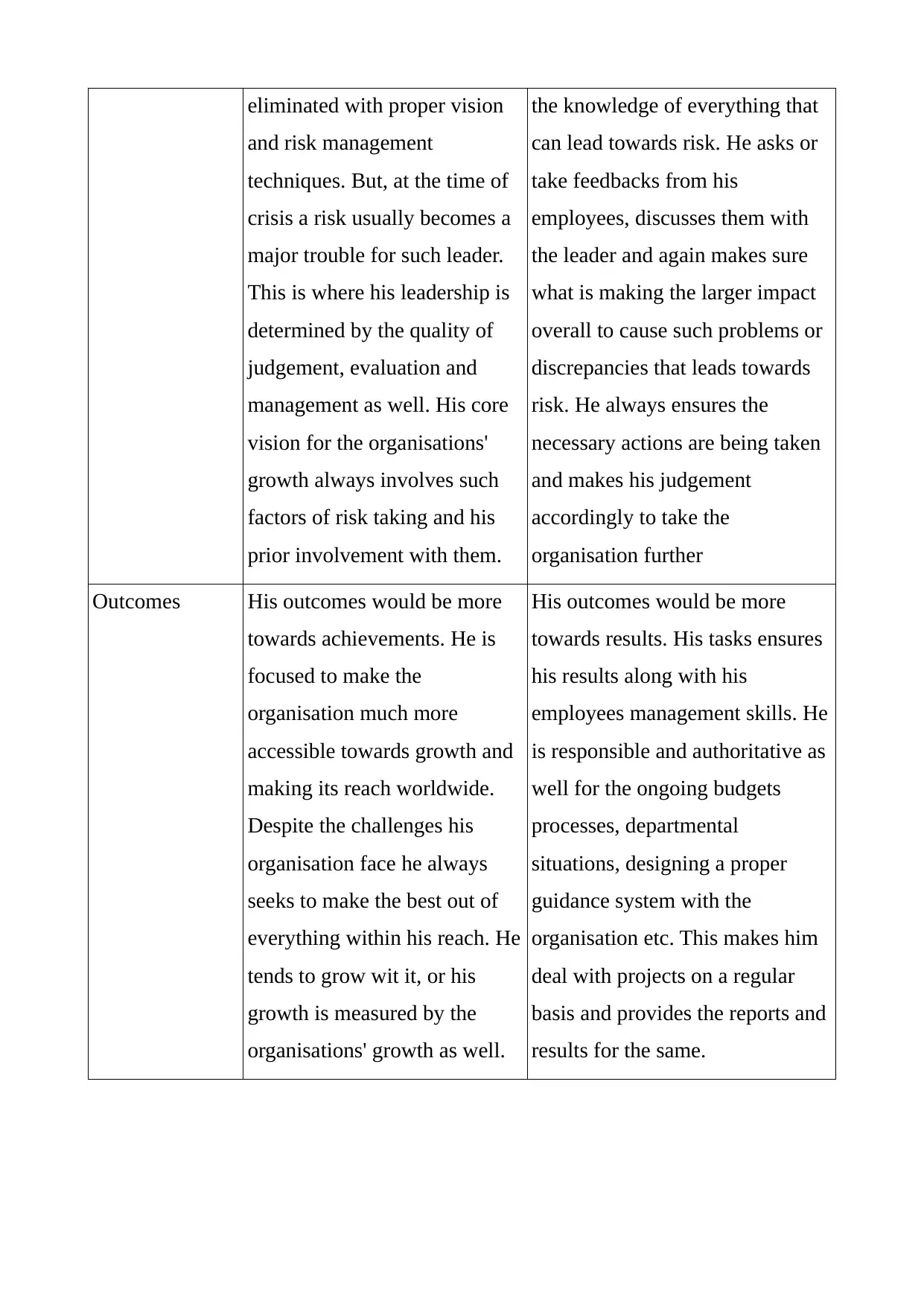
eliminated with proper vision
and risk management
techniques. But, at the time of
crisis a risk usually becomes a
major trouble for such leader.
This is where his leadership is
determined by the quality of
judgement, evaluation and
management as well. His core
vision for the organisations'
growth always involves such
factors of risk taking and his
prior involvement with them.
the knowledge of everything that
can lead towards risk. He asks or
take feedbacks from his
employees, discusses them with
the leader and again makes sure
what is making the larger impact
overall to cause such problems or
discrepancies that leads towards
risk. He always ensures the
necessary actions are being taken
and makes his judgement
accordingly to take the
organisation further
Outcomes His outcomes would be more
towards achievements. He is
focused to make the
organisation much more
accessible towards growth and
making its reach worldwide.
Despite the challenges his
organisation face he always
seeks to make the best out of
everything within his reach. He
tends to grow wit it, or his
growth is measured by the
organisations' growth as well.
His outcomes would be more
towards results. His tasks ensures
his results along with his
employees management skills. He
is responsible and authoritative as
well for the ongoing budgets
processes, departmental
situations, designing a proper
guidance system with the
organisation etc. This makes him
deal with projects on a regular
basis and provides the reports and
results for the same.
and risk management
techniques. But, at the time of
crisis a risk usually becomes a
major trouble for such leader.
This is where his leadership is
determined by the quality of
judgement, evaluation and
management as well. His core
vision for the organisations'
growth always involves such
factors of risk taking and his
prior involvement with them.
the knowledge of everything that
can lead towards risk. He asks or
take feedbacks from his
employees, discusses them with
the leader and again makes sure
what is making the larger impact
overall to cause such problems or
discrepancies that leads towards
risk. He always ensures the
necessary actions are being taken
and makes his judgement
accordingly to take the
organisation further
Outcomes His outcomes would be more
towards achievements. He is
focused to make the
organisation much more
accessible towards growth and
making its reach worldwide.
Despite the challenges his
organisation face he always
seeks to make the best out of
everything within his reach. He
tends to grow wit it, or his
growth is measured by the
organisations' growth as well.
His outcomes would be more
towards results. His tasks ensures
his results along with his
employees management skills. He
is responsible and authoritative as
well for the ongoing budgets
processes, departmental
situations, designing a proper
guidance system with the
organisation etc. This makes him
deal with projects on a regular
basis and provides the reports and
results for the same.
Paraphrase This Document
Need a fresh take? Get an instant paraphrase of this document with our AI Paraphraser
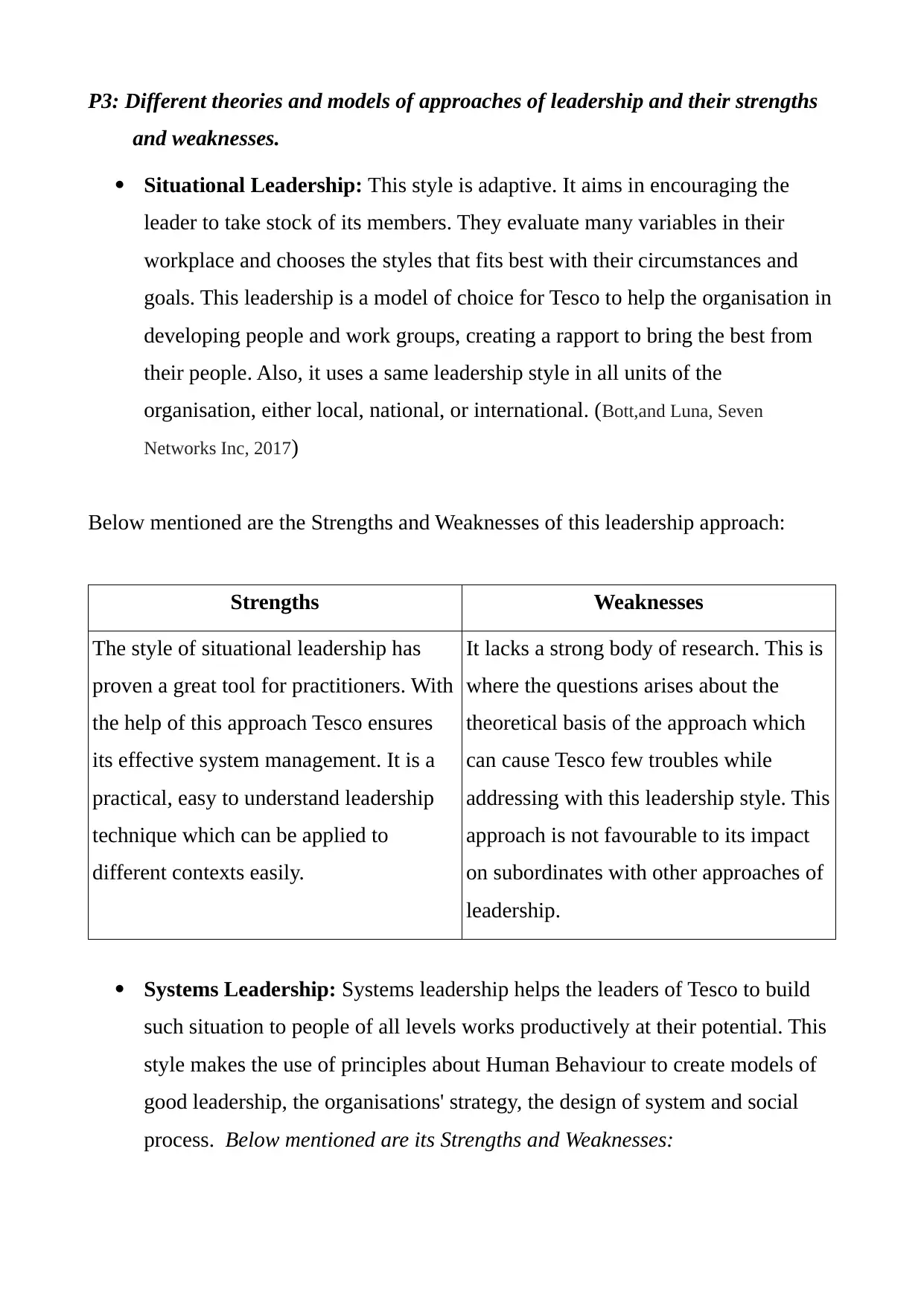
P3: Different theories and models of approaches of leadership and their strengths
and weaknesses.
Situational Leadership: This style is adaptive. It aims in encouraging the
leader to take stock of its members. They evaluate many variables in their
workplace and chooses the styles that fits best with their circumstances and
goals. This leadership is a model of choice for Tesco to help the organisation in
developing people and work groups, creating a rapport to bring the best from
their people. Also, it uses a same leadership style in all units of the
organisation, either local, national, or international. (Bott,and Luna, Seven
Networks Inc, 2017)
Below mentioned are the Strengths and Weaknesses of this leadership approach:
Strengths Weaknesses
The style of situational leadership has
proven a great tool for practitioners. With
the help of this approach Tesco ensures
its effective system management. It is a
practical, easy to understand leadership
technique which can be applied to
different contexts easily.
It lacks a strong body of research. This is
where the questions arises about the
theoretical basis of the approach which
can cause Tesco few troubles while
addressing with this leadership style. This
approach is not favourable to its impact
on subordinates with other approaches of
leadership.
Systems Leadership: Systems leadership helps the leaders of Tesco to build
such situation to people of all levels works productively at their potential. This
style makes the use of principles about Human Behaviour to create models of
good leadership, the organisations' strategy, the design of system and social
process. Below mentioned are its Strengths and Weaknesses:
and weaknesses.
Situational Leadership: This style is adaptive. It aims in encouraging the
leader to take stock of its members. They evaluate many variables in their
workplace and chooses the styles that fits best with their circumstances and
goals. This leadership is a model of choice for Tesco to help the organisation in
developing people and work groups, creating a rapport to bring the best from
their people. Also, it uses a same leadership style in all units of the
organisation, either local, national, or international. (Bott,and Luna, Seven
Networks Inc, 2017)
Below mentioned are the Strengths and Weaknesses of this leadership approach:
Strengths Weaknesses
The style of situational leadership has
proven a great tool for practitioners. With
the help of this approach Tesco ensures
its effective system management. It is a
practical, easy to understand leadership
technique which can be applied to
different contexts easily.
It lacks a strong body of research. This is
where the questions arises about the
theoretical basis of the approach which
can cause Tesco few troubles while
addressing with this leadership style. This
approach is not favourable to its impact
on subordinates with other approaches of
leadership.
Systems Leadership: Systems leadership helps the leaders of Tesco to build
such situation to people of all levels works productively at their potential. This
style makes the use of principles about Human Behaviour to create models of
good leadership, the organisations' strategy, the design of system and social
process. Below mentioned are its Strengths and Weaknesses:
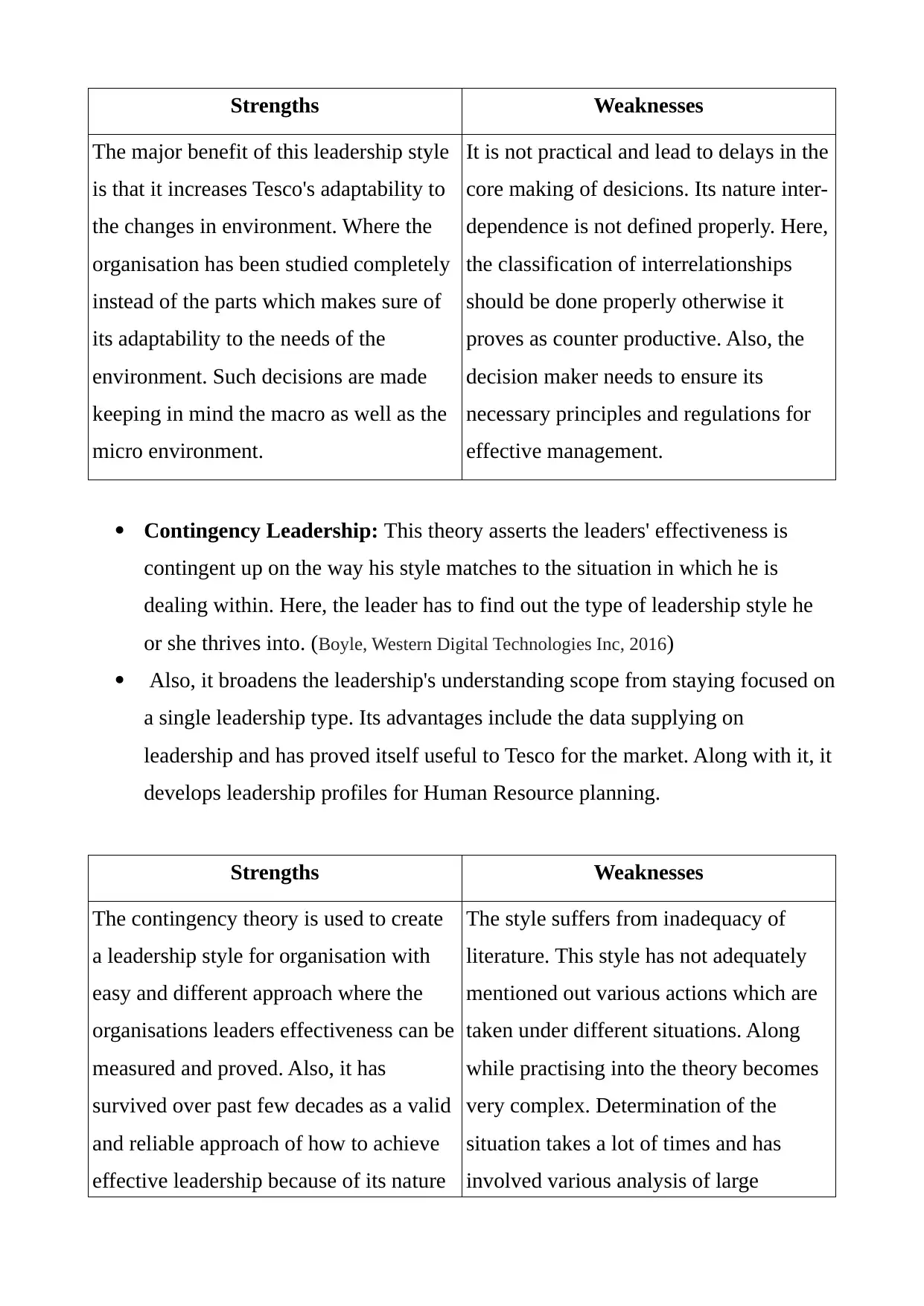
Strengths Weaknesses
The major benefit of this leadership style
is that it increases Tesco's adaptability to
the changes in environment. Where the
organisation has been studied completely
instead of the parts which makes sure of
its adaptability to the needs of the
environment. Such decisions are made
keeping in mind the macro as well as the
micro environment.
It is not practical and lead to delays in the
core making of desicions. Its nature inter-
dependence is not defined properly. Here,
the classification of interrelationships
should be done properly otherwise it
proves as counter productive. Also, the
decision maker needs to ensure its
necessary principles and regulations for
effective management.
Contingency Leadership: This theory asserts the leaders' effectiveness is
contingent up on the way his style matches to the situation in which he is
dealing within. Here, the leader has to find out the type of leadership style he
or she thrives into. (Boyle, Western Digital Technologies Inc, 2016)
Also, it broadens the leadership's understanding scope from staying focused on
a single leadership type. Its advantages include the data supplying on
leadership and has proved itself useful to Tesco for the market. Along with it, it
develops leadership profiles for Human Resource planning.
Strengths Weaknesses
The contingency theory is used to create
a leadership style for organisation with
easy and different approach where the
organisations leaders effectiveness can be
measured and proved. Also, it has
survived over past few decades as a valid
and reliable approach of how to achieve
effective leadership because of its nature
The style suffers from inadequacy of
literature. This style has not adequately
mentioned out various actions which are
taken under different situations. Along
while practising into the theory becomes
very complex. Determination of the
situation takes a lot of times and has
involved various analysis of large
The major benefit of this leadership style
is that it increases Tesco's adaptability to
the changes in environment. Where the
organisation has been studied completely
instead of the parts which makes sure of
its adaptability to the needs of the
environment. Such decisions are made
keeping in mind the macro as well as the
micro environment.
It is not practical and lead to delays in the
core making of desicions. Its nature inter-
dependence is not defined properly. Here,
the classification of interrelationships
should be done properly otherwise it
proves as counter productive. Also, the
decision maker needs to ensure its
necessary principles and regulations for
effective management.
Contingency Leadership: This theory asserts the leaders' effectiveness is
contingent up on the way his style matches to the situation in which he is
dealing within. Here, the leader has to find out the type of leadership style he
or she thrives into. (Boyle, Western Digital Technologies Inc, 2016)
Also, it broadens the leadership's understanding scope from staying focused on
a single leadership type. Its advantages include the data supplying on
leadership and has proved itself useful to Tesco for the market. Along with it, it
develops leadership profiles for Human Resource planning.
Strengths Weaknesses
The contingency theory is used to create
a leadership style for organisation with
easy and different approach where the
organisations leaders effectiveness can be
measured and proved. Also, it has
survived over past few decades as a valid
and reliable approach of how to achieve
effective leadership because of its nature
The style suffers from inadequacy of
literature. This style has not adequately
mentioned out various actions which are
taken under different situations. Along
while practising into the theory becomes
very complex. Determination of the
situation takes a lot of times and has
involved various analysis of large
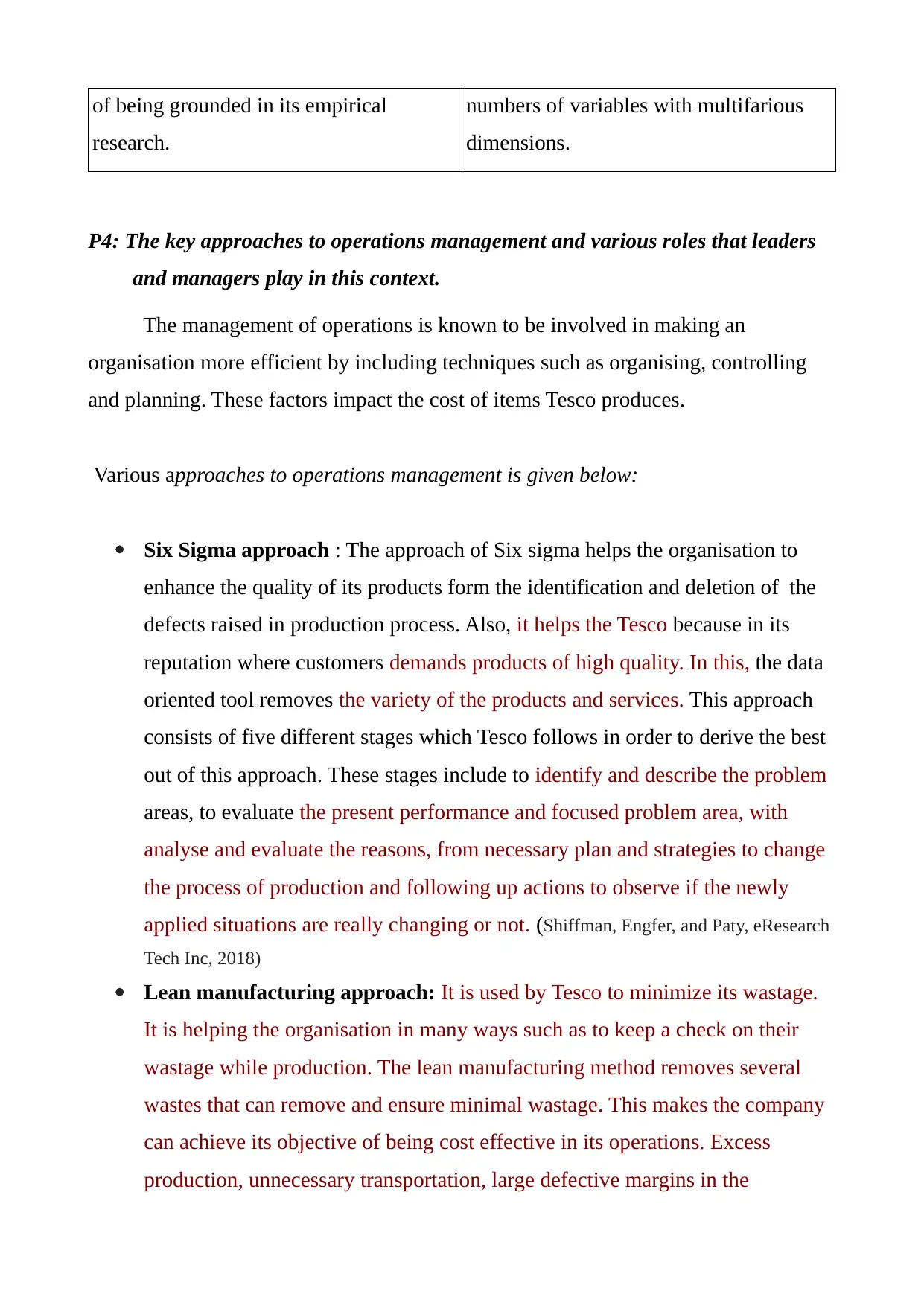
of being grounded in its empirical
research.
numbers of variables with multifarious
dimensions.
P4: The key approaches to operations management and various roles that leaders
and managers play in this context.
The management of operations is known to be involved in making an
organisation more efficient by including techniques such as organising, controlling
and planning. These factors impact the cost of items Tesco produces.
Various approaches to operations management is given below:
Six Sigma approach : The approach of Six sigma helps the organisation to
enhance the quality of its products form the identification and deletion of the
defects raised in production process. Also, it helps the Tesco because in its
reputation where customers demands products of high quality. In this, the data
oriented tool removes the variety of the products and services. This approach
consists of five different stages which Tesco follows in order to derive the best
out of this approach. These stages include to identify and describe the problem
areas, to evaluate the present performance and focused problem area, with
analyse and evaluate the reasons, from necessary plan and strategies to change
the process of production and following up actions to observe if the newly
applied situations are really changing or not. (Shiffman, Engfer, and Paty, eResearch
Tech Inc, 2018)
Lean manufacturing approach: It is used by Tesco to minimize its wastage.
It is helping the organisation in many ways such as to keep a check on their
wastage while production. The lean manufacturing method removes several
wastes that can remove and ensure minimal wastage. This makes the company
can achieve its objective of being cost effective in its operations. Excess
production, unnecessary transportation, large defective margins in the
research.
numbers of variables with multifarious
dimensions.
P4: The key approaches to operations management and various roles that leaders
and managers play in this context.
The management of operations is known to be involved in making an
organisation more efficient by including techniques such as organising, controlling
and planning. These factors impact the cost of items Tesco produces.
Various approaches to operations management is given below:
Six Sigma approach : The approach of Six sigma helps the organisation to
enhance the quality of its products form the identification and deletion of the
defects raised in production process. Also, it helps the Tesco because in its
reputation where customers demands products of high quality. In this, the data
oriented tool removes the variety of the products and services. This approach
consists of five different stages which Tesco follows in order to derive the best
out of this approach. These stages include to identify and describe the problem
areas, to evaluate the present performance and focused problem area, with
analyse and evaluate the reasons, from necessary plan and strategies to change
the process of production and following up actions to observe if the newly
applied situations are really changing or not. (Shiffman, Engfer, and Paty, eResearch
Tech Inc, 2018)
Lean manufacturing approach: It is used by Tesco to minimize its wastage.
It is helping the organisation in many ways such as to keep a check on their
wastage while production. The lean manufacturing method removes several
wastes that can remove and ensure minimal wastage. This makes the company
can achieve its objective of being cost effective in its operations. Excess
production, unnecessary transportation, large defective margins in the
Secure Best Marks with AI Grader
Need help grading? Try our AI Grader for instant feedback on your assignments.
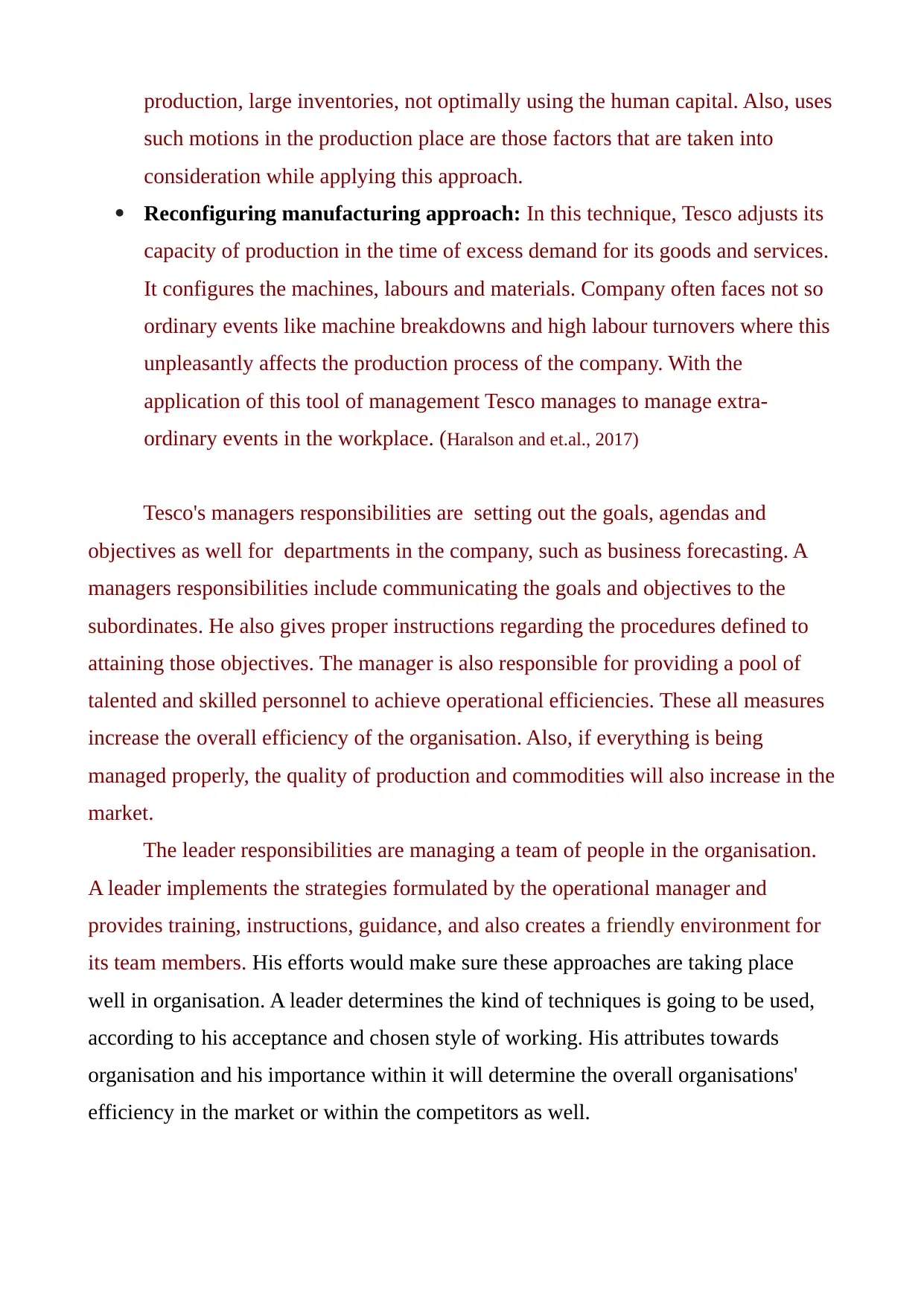
production, large inventories, not optimally using the human capital. Also, uses
such motions in the production place are those factors that are taken into
consideration while applying this approach.
Reconfiguring manufacturing approach: In this technique, Tesco adjusts its
capacity of production in the time of excess demand for its goods and services.
It configures the machines, labours and materials. Company often faces not so
ordinary events like machine breakdowns and high labour turnovers where this
unpleasantly affects the production process of the company. With the
application of this tool of management Tesco manages to manage extra-
ordinary events in the workplace. (Haralson and et.al., 2017)
Tesco's managers responsibilities are setting out the goals, agendas and
objectives as well for departments in the company, such as business forecasting. A
managers responsibilities include communicating the goals and objectives to the
subordinates. He also gives proper instructions regarding the procedures defined to
attaining those objectives. The manager is also responsible for providing a pool of
talented and skilled personnel to achieve operational efficiencies. These all measures
increase the overall efficiency of the organisation. Also, if everything is being
managed properly, the quality of production and commodities will also increase in the
market.
The leader responsibilities are managing a team of people in the organisation.
A leader implements the strategies formulated by the operational manager and
provides training, instructions, guidance, and also creates a friendly environment for
its team members. His efforts would make sure these approaches are taking place
well in organisation. A leader determines the kind of techniques is going to be used,
according to his acceptance and chosen style of working. His attributes towards
organisation and his importance within it will determine the overall organisations'
efficiency in the market or within the competitors as well.
such motions in the production place are those factors that are taken into
consideration while applying this approach.
Reconfiguring manufacturing approach: In this technique, Tesco adjusts its
capacity of production in the time of excess demand for its goods and services.
It configures the machines, labours and materials. Company often faces not so
ordinary events like machine breakdowns and high labour turnovers where this
unpleasantly affects the production process of the company. With the
application of this tool of management Tesco manages to manage extra-
ordinary events in the workplace. (Haralson and et.al., 2017)
Tesco's managers responsibilities are setting out the goals, agendas and
objectives as well for departments in the company, such as business forecasting. A
managers responsibilities include communicating the goals and objectives to the
subordinates. He also gives proper instructions regarding the procedures defined to
attaining those objectives. The manager is also responsible for providing a pool of
talented and skilled personnel to achieve operational efficiencies. These all measures
increase the overall efficiency of the organisation. Also, if everything is being
managed properly, the quality of production and commodities will also increase in the
market.
The leader responsibilities are managing a team of people in the organisation.
A leader implements the strategies formulated by the operational manager and
provides training, instructions, guidance, and also creates a friendly environment for
its team members. His efforts would make sure these approaches are taking place
well in organisation. A leader determines the kind of techniques is going to be used,
according to his acceptance and chosen style of working. His attributes towards
organisation and his importance within it will determine the overall organisations'
efficiency in the market or within the competitors as well.
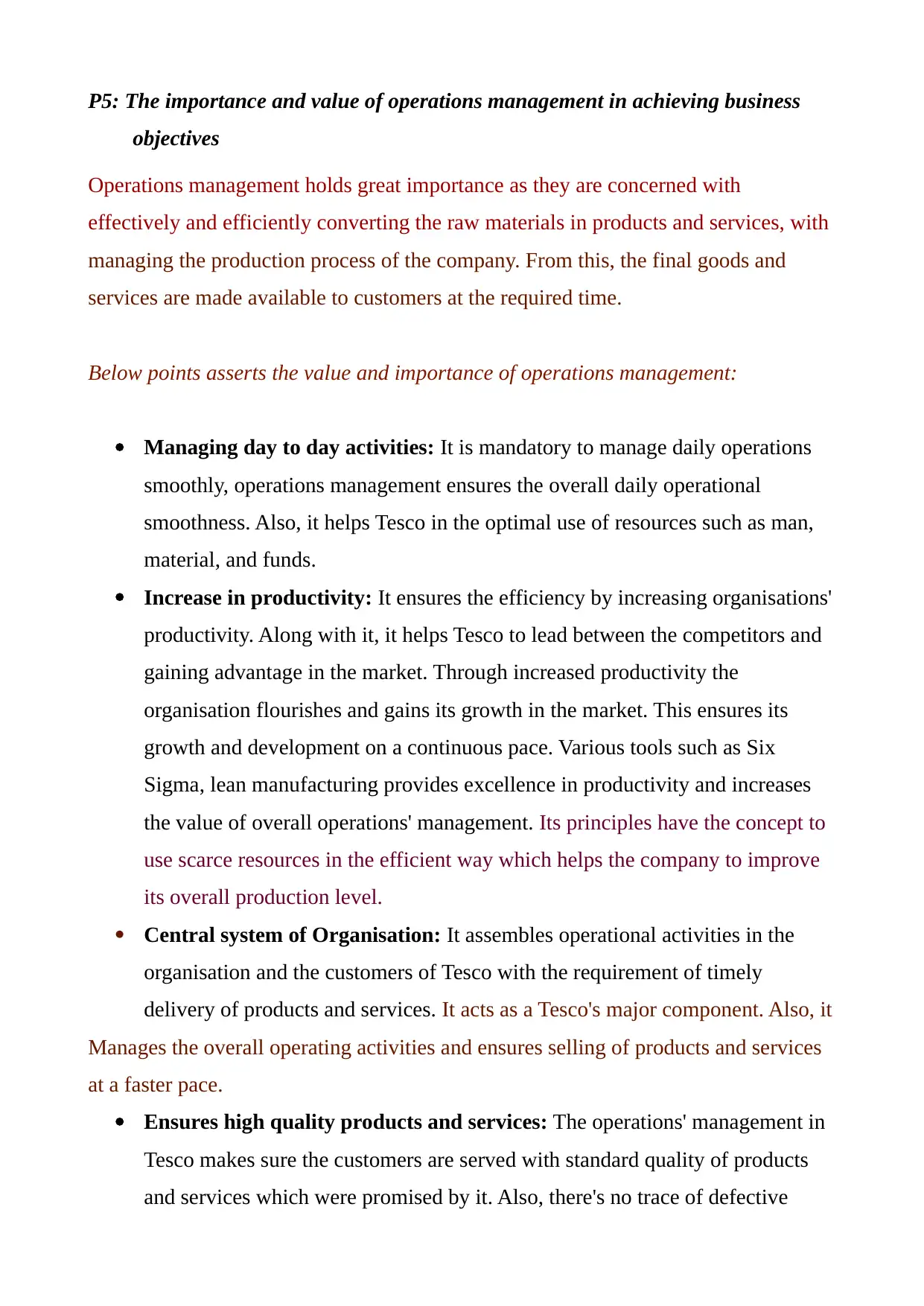
P5: The importance and value of operations management in achieving business
objectives
Operations management holds great importance as they are concerned with
effectively and efficiently converting the raw materials in products and services, with
managing the production process of the company. From this, the final goods and
services are made available to customers at the required time.
Below points asserts the value and importance of operations management:
Managing day to day activities: It is mandatory to manage daily operations
smoothly, operations management ensures the overall daily operational
smoothness. Also, it helps Tesco in the optimal use of resources such as man,
material, and funds.
Increase in productivity: It ensures the efficiency by increasing organisations'
productivity. Along with it, it helps Tesco to lead between the competitors and
gaining advantage in the market. Through increased productivity the
organisation flourishes and gains its growth in the market. This ensures its
growth and development on a continuous pace. Various tools such as Six
Sigma, lean manufacturing provides excellence in productivity and increases
the value of overall operations' management. Its principles have the concept to
use scarce resources in the efficient way which helps the company to improve
its overall production level.
Central system of Organisation: It assembles operational activities in the
organisation and the customers of Tesco with the requirement of timely
delivery of products and services. It acts as a Tesco's major component. Also, it
Manages the overall operating activities and ensures selling of products and services
at a faster pace.
Ensures high quality products and services: The operations' management in
Tesco makes sure the customers are served with standard quality of products
and services which were promised by it. Also, there's no trace of defective
objectives
Operations management holds great importance as they are concerned with
effectively and efficiently converting the raw materials in products and services, with
managing the production process of the company. From this, the final goods and
services are made available to customers at the required time.
Below points asserts the value and importance of operations management:
Managing day to day activities: It is mandatory to manage daily operations
smoothly, operations management ensures the overall daily operational
smoothness. Also, it helps Tesco in the optimal use of resources such as man,
material, and funds.
Increase in productivity: It ensures the efficiency by increasing organisations'
productivity. Along with it, it helps Tesco to lead between the competitors and
gaining advantage in the market. Through increased productivity the
organisation flourishes and gains its growth in the market. This ensures its
growth and development on a continuous pace. Various tools such as Six
Sigma, lean manufacturing provides excellence in productivity and increases
the value of overall operations' management. Its principles have the concept to
use scarce resources in the efficient way which helps the company to improve
its overall production level.
Central system of Organisation: It assembles operational activities in the
organisation and the customers of Tesco with the requirement of timely
delivery of products and services. It acts as a Tesco's major component. Also, it
Manages the overall operating activities and ensures selling of products and services
at a faster pace.
Ensures high quality products and services: The operations' management in
Tesco makes sure the customers are served with standard quality of products
and services which were promised by it. Also, there's no trace of defective
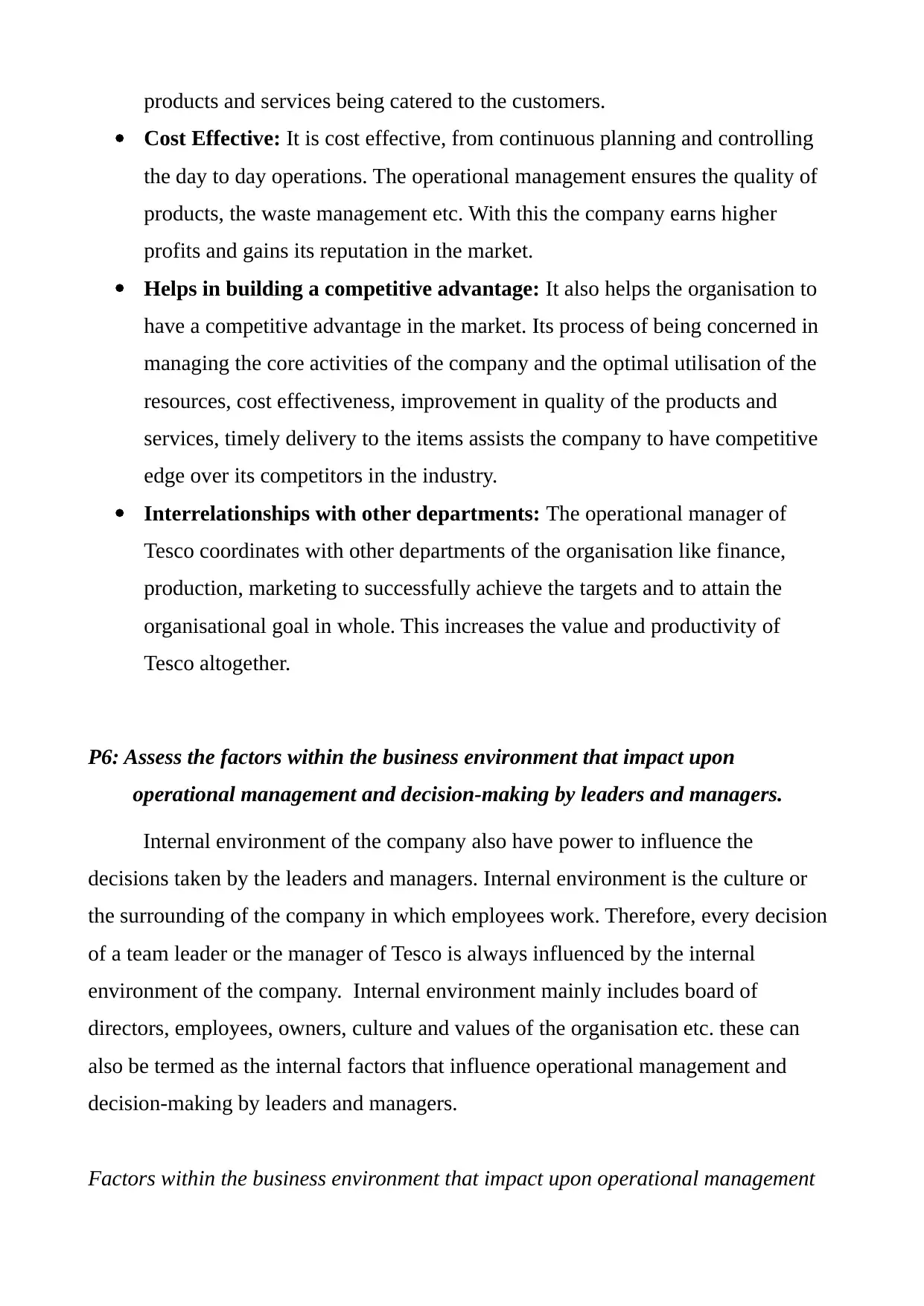
products and services being catered to the customers.
Cost Effective: It is cost effective, from continuous planning and controlling
the day to day operations. The operational management ensures the quality of
products, the waste management etc. With this the company earns higher
profits and gains its reputation in the market.
Helps in building a competitive advantage: It also helps the organisation to
have a competitive advantage in the market. Its process of being concerned in
managing the core activities of the company and the optimal utilisation of the
resources, cost effectiveness, improvement in quality of the products and
services, timely delivery to the items assists the company to have competitive
edge over its competitors in the industry.
Interrelationships with other departments: The operational manager of
Tesco coordinates with other departments of the organisation like finance,
production, marketing to successfully achieve the targets and to attain the
organisational goal in whole. This increases the value and productivity of
Tesco altogether.
P6: Assess the factors within the business environment that impact upon
operational management and decision-making by leaders and managers.
Internal environment of the company also have power to influence the
decisions taken by the leaders and managers. Internal environment is the culture or
the surrounding of the company in which employees work. Therefore, every decision
of a team leader or the manager of Tesco is always influenced by the internal
environment of the company. Internal environment mainly includes board of
directors, employees, owners, culture and values of the organisation etc. these can
also be termed as the internal factors that influence operational management and
decision-making by leaders and managers.
Factors within the business environment that impact upon operational management
Cost Effective: It is cost effective, from continuous planning and controlling
the day to day operations. The operational management ensures the quality of
products, the waste management etc. With this the company earns higher
profits and gains its reputation in the market.
Helps in building a competitive advantage: It also helps the organisation to
have a competitive advantage in the market. Its process of being concerned in
managing the core activities of the company and the optimal utilisation of the
resources, cost effectiveness, improvement in quality of the products and
services, timely delivery to the items assists the company to have competitive
edge over its competitors in the industry.
Interrelationships with other departments: The operational manager of
Tesco coordinates with other departments of the organisation like finance,
production, marketing to successfully achieve the targets and to attain the
organisational goal in whole. This increases the value and productivity of
Tesco altogether.
P6: Assess the factors within the business environment that impact upon
operational management and decision-making by leaders and managers.
Internal environment of the company also have power to influence the
decisions taken by the leaders and managers. Internal environment is the culture or
the surrounding of the company in which employees work. Therefore, every decision
of a team leader or the manager of Tesco is always influenced by the internal
environment of the company. Internal environment mainly includes board of
directors, employees, owners, culture and values of the organisation etc. these can
also be termed as the internal factors that influence operational management and
decision-making by leaders and managers.
Factors within the business environment that impact upon operational management
Paraphrase This Document
Need a fresh take? Get an instant paraphrase of this document with our AI Paraphraser
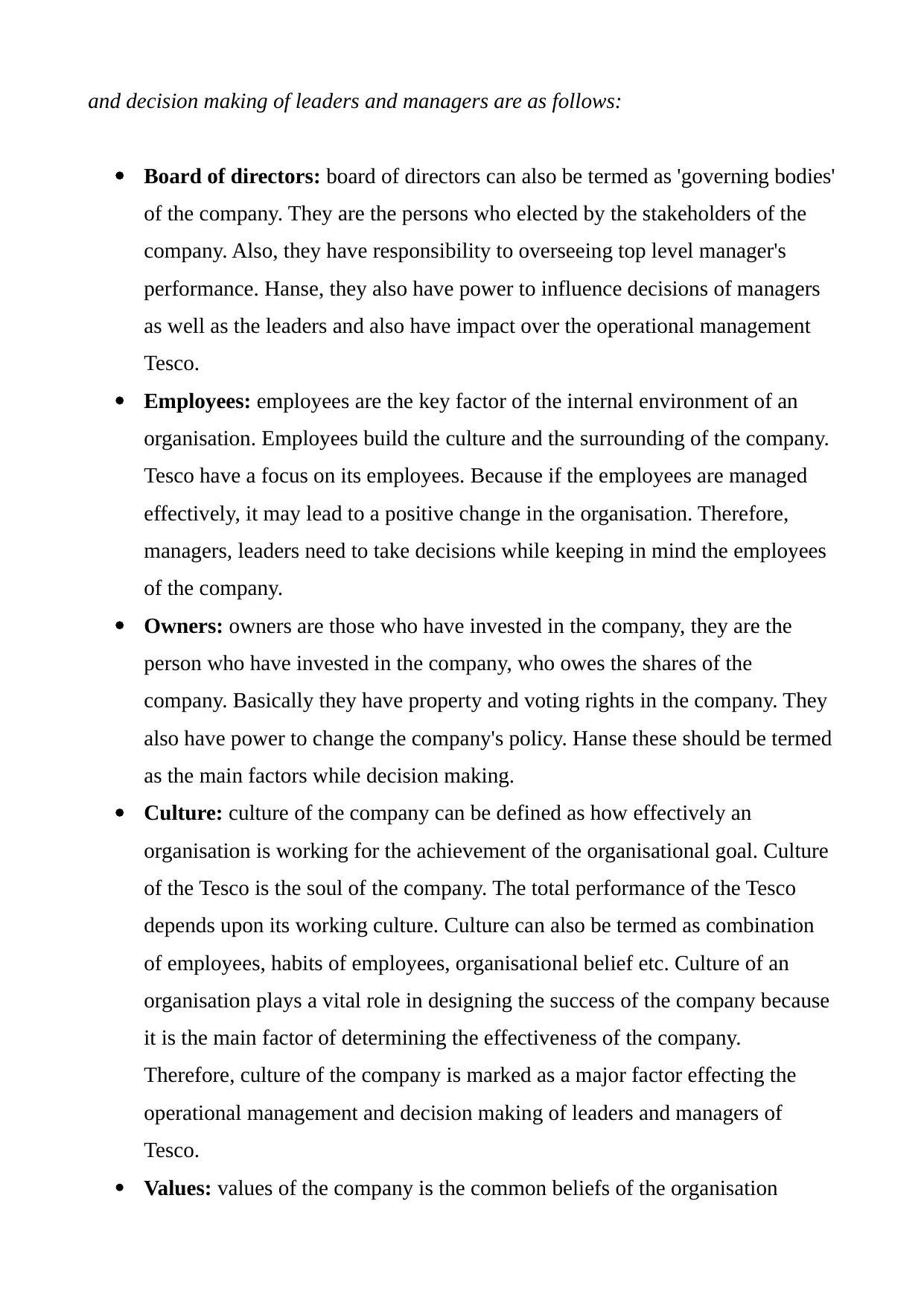
and decision making of leaders and managers are as follows:
Board of directors: board of directors can also be termed as 'governing bodies'
of the company. They are the persons who elected by the stakeholders of the
company. Also, they have responsibility to overseeing top level manager's
performance. Hanse, they also have power to influence decisions of managers
as well as the leaders and also have impact over the operational management
Tesco.
Employees: employees are the key factor of the internal environment of an
organisation. Employees build the culture and the surrounding of the company.
Tesco have a focus on its employees. Because if the employees are managed
effectively, it may lead to a positive change in the organisation. Therefore,
managers, leaders need to take decisions while keeping in mind the employees
of the company.
Owners: owners are those who have invested in the company, they are the
person who have invested in the company, who owes the shares of the
company. Basically they have property and voting rights in the company. They
also have power to change the company's policy. Hanse these should be termed
as the main factors while decision making.
Culture: culture of the company can be defined as how effectively an
organisation is working for the achievement of the organisational goal. Culture
of the Tesco is the soul of the company. The total performance of the Tesco
depends upon its working culture. Culture can also be termed as combination
of employees, habits of employees, organisational belief etc. Culture of an
organisation plays a vital role in designing the success of the company because
it is the main factor of determining the effectiveness of the company.
Therefore, culture of the company is marked as a major factor effecting the
operational management and decision making of leaders and managers of
Tesco.
Values: values of the company is the common beliefs of the organisation
Board of directors: board of directors can also be termed as 'governing bodies'
of the company. They are the persons who elected by the stakeholders of the
company. Also, they have responsibility to overseeing top level manager's
performance. Hanse, they also have power to influence decisions of managers
as well as the leaders and also have impact over the operational management
Tesco.
Employees: employees are the key factor of the internal environment of an
organisation. Employees build the culture and the surrounding of the company.
Tesco have a focus on its employees. Because if the employees are managed
effectively, it may lead to a positive change in the organisation. Therefore,
managers, leaders need to take decisions while keeping in mind the employees
of the company.
Owners: owners are those who have invested in the company, they are the
person who have invested in the company, who owes the shares of the
company. Basically they have property and voting rights in the company. They
also have power to change the company's policy. Hanse these should be termed
as the main factors while decision making.
Culture: culture of the company can be defined as how effectively an
organisation is working for the achievement of the organisational goal. Culture
of the Tesco is the soul of the company. The total performance of the Tesco
depends upon its working culture. Culture can also be termed as combination
of employees, habits of employees, organisational belief etc. Culture of an
organisation plays a vital role in designing the success of the company because
it is the main factor of determining the effectiveness of the company.
Therefore, culture of the company is marked as a major factor effecting the
operational management and decision making of leaders and managers of
Tesco.
Values: values of the company is the common beliefs of the organisation
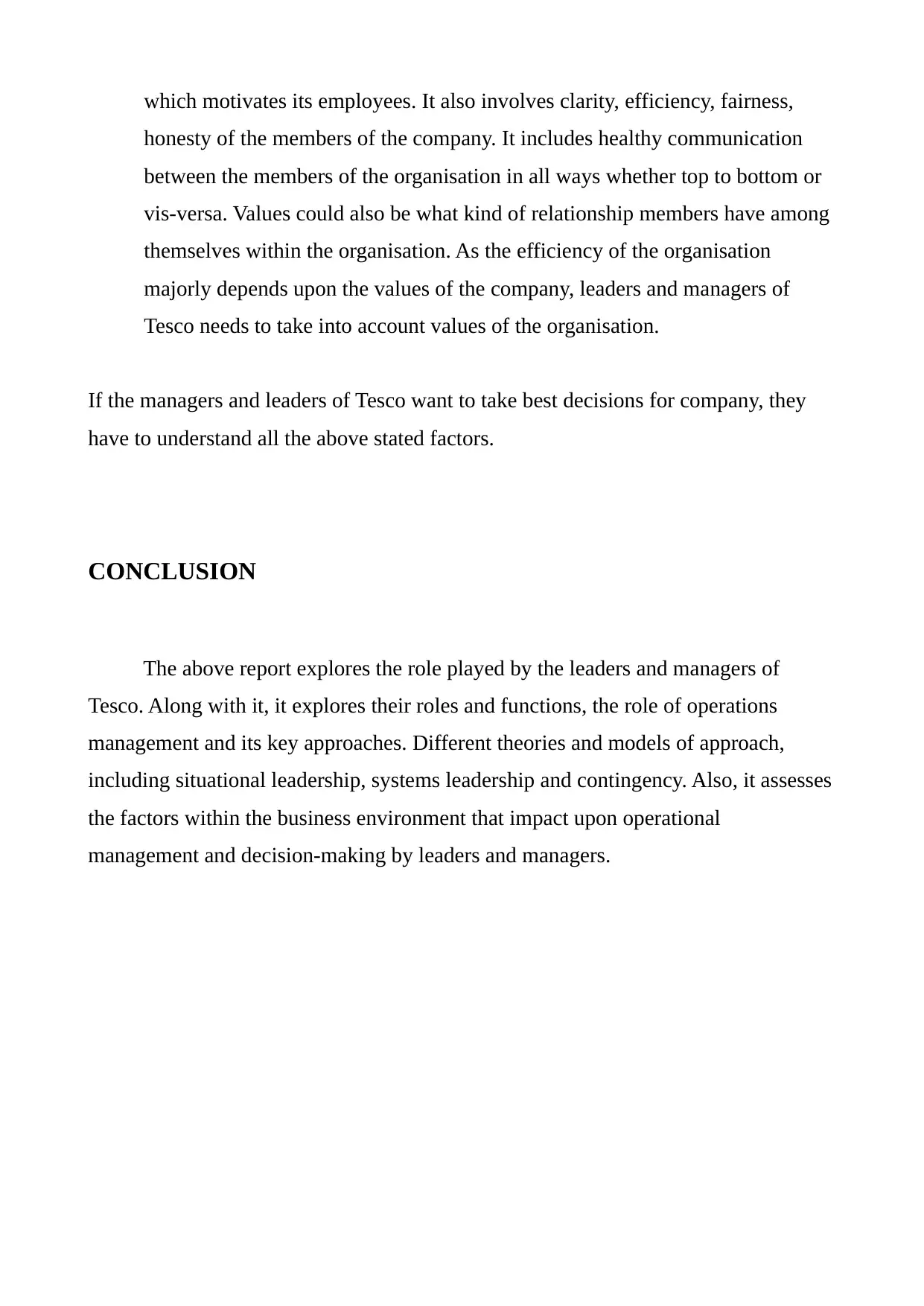
which motivates its employees. It also involves clarity, efficiency, fairness,
honesty of the members of the company. It includes healthy communication
between the members of the organisation in all ways whether top to bottom or
vis-versa. Values could also be what kind of relationship members have among
themselves within the organisation. As the efficiency of the organisation
majorly depends upon the values of the company, leaders and managers of
Tesco needs to take into account values of the organisation.
If the managers and leaders of Tesco want to take best decisions for company, they
have to understand all the above stated factors.
CONCLUSION
The above report explores the role played by the leaders and managers of
Tesco. Along with it, it explores their roles and functions, the role of operations
management and its key approaches. Different theories and models of approach,
including situational leadership, systems leadership and contingency. Also, it assesses
the factors within the business environment that impact upon operational
management and decision-making by leaders and managers.
honesty of the members of the company. It includes healthy communication
between the members of the organisation in all ways whether top to bottom or
vis-versa. Values could also be what kind of relationship members have among
themselves within the organisation. As the efficiency of the organisation
majorly depends upon the values of the company, leaders and managers of
Tesco needs to take into account values of the organisation.
If the managers and leaders of Tesco want to take best decisions for company, they
have to understand all the above stated factors.
CONCLUSION
The above report explores the role played by the leaders and managers of
Tesco. Along with it, it explores their roles and functions, the role of operations
management and its key approaches. Different theories and models of approach,
including situational leadership, systems leadership and contingency. Also, it assesses
the factors within the business environment that impact upon operational
management and decision-making by leaders and managers.
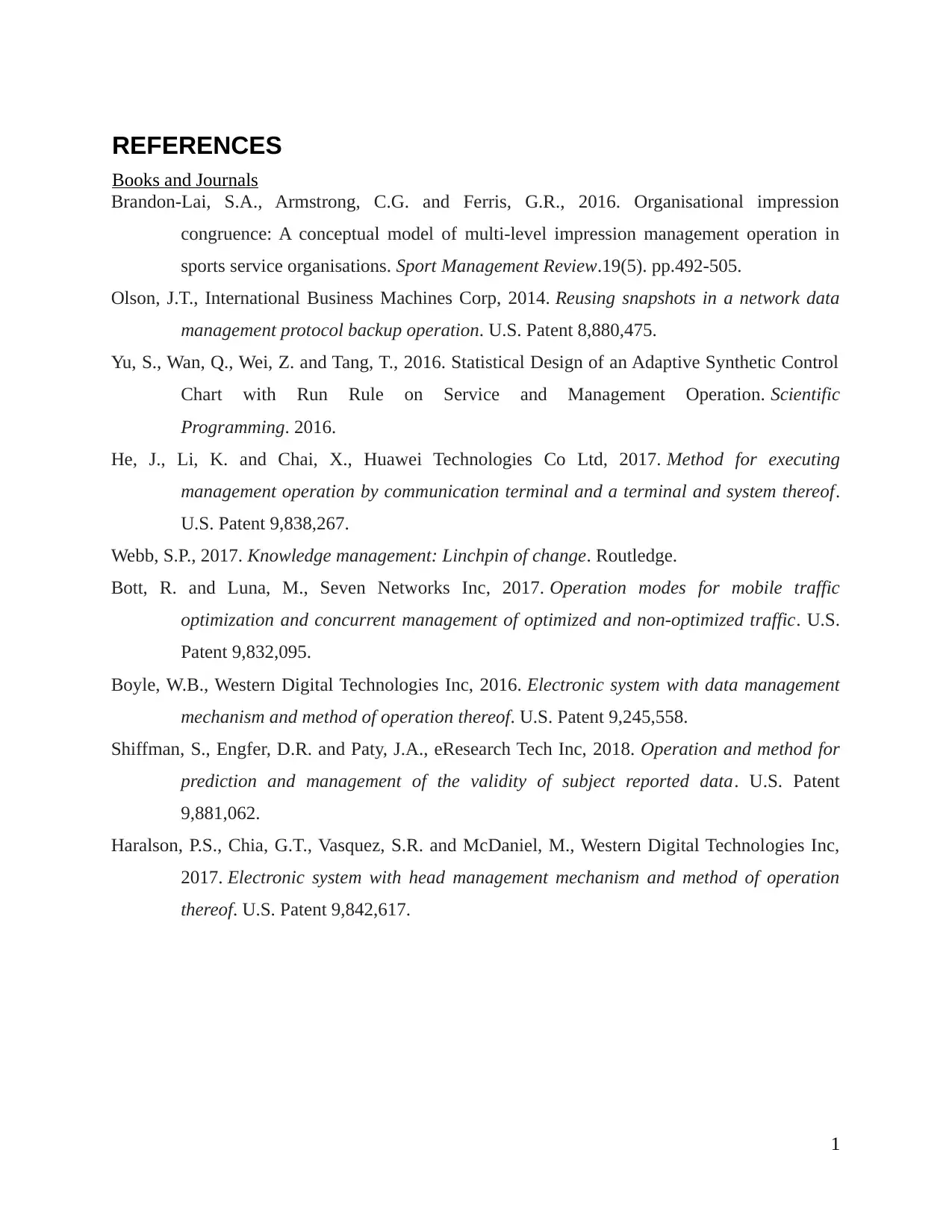
REFERENCES
Books and Journals
Brandon-Lai, S.A., Armstrong, C.G. and Ferris, G.R., 2016. Organisational impression
congruence: A conceptual model of multi-level impression management operation in
sports service organisations. Sport Management Review.19(5). pp.492-505.
Olson, J.T., International Business Machines Corp, 2014. Reusing snapshots in a network data
management protocol backup operation. U.S. Patent 8,880,475.
Yu, S., Wan, Q., Wei, Z. and Tang, T., 2016. Statistical Design of an Adaptive Synthetic Control
Chart with Run Rule on Service and Management Operation. Scientific
Programming. 2016.
He, J., Li, K. and Chai, X., Huawei Technologies Co Ltd, 2017. Method for executing
management operation by communication terminal and a terminal and system thereof.
U.S. Patent 9,838,267.
Webb, S.P., 2017. Knowledge management: Linchpin of change. Routledge.
Bott, R. and Luna, M., Seven Networks Inc, 2017. Operation modes for mobile traffic
optimization and concurrent management of optimized and non-optimized traffic. U.S.
Patent 9,832,095.
Boyle, W.B., Western Digital Technologies Inc, 2016. Electronic system with data management
mechanism and method of operation thereof. U.S. Patent 9,245,558.
Shiffman, S., Engfer, D.R. and Paty, J.A., eResearch Tech Inc, 2018. Operation and method for
prediction and management of the validity of subject reported data. U.S. Patent
9,881,062.
Haralson, P.S., Chia, G.T., Vasquez, S.R. and McDaniel, M., Western Digital Technologies Inc,
2017. Electronic system with head management mechanism and method of operation
thereof. U.S. Patent 9,842,617.
1
Books and Journals
Brandon-Lai, S.A., Armstrong, C.G. and Ferris, G.R., 2016. Organisational impression
congruence: A conceptual model of multi-level impression management operation in
sports service organisations. Sport Management Review.19(5). pp.492-505.
Olson, J.T., International Business Machines Corp, 2014. Reusing snapshots in a network data
management protocol backup operation. U.S. Patent 8,880,475.
Yu, S., Wan, Q., Wei, Z. and Tang, T., 2016. Statistical Design of an Adaptive Synthetic Control
Chart with Run Rule on Service and Management Operation. Scientific
Programming. 2016.
He, J., Li, K. and Chai, X., Huawei Technologies Co Ltd, 2017. Method for executing
management operation by communication terminal and a terminal and system thereof.
U.S. Patent 9,838,267.
Webb, S.P., 2017. Knowledge management: Linchpin of change. Routledge.
Bott, R. and Luna, M., Seven Networks Inc, 2017. Operation modes for mobile traffic
optimization and concurrent management of optimized and non-optimized traffic. U.S.
Patent 9,832,095.
Boyle, W.B., Western Digital Technologies Inc, 2016. Electronic system with data management
mechanism and method of operation thereof. U.S. Patent 9,245,558.
Shiffman, S., Engfer, D.R. and Paty, J.A., eResearch Tech Inc, 2018. Operation and method for
prediction and management of the validity of subject reported data. U.S. Patent
9,881,062.
Haralson, P.S., Chia, G.T., Vasquez, S.R. and McDaniel, M., Western Digital Technologies Inc,
2017. Electronic system with head management mechanism and method of operation
thereof. U.S. Patent 9,842,617.
1
1 out of 16
Related Documents
Your All-in-One AI-Powered Toolkit for Academic Success.
+13062052269
info@desklib.com
Available 24*7 on WhatsApp / Email
![[object Object]](/_next/static/media/star-bottom.7253800d.svg)
Unlock your academic potential
© 2024 | Zucol Services PVT LTD | All rights reserved.





